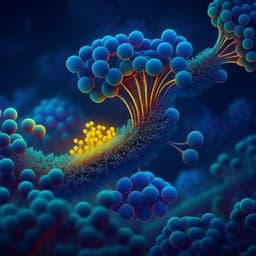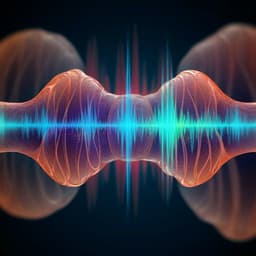
Engineering and Technology
Metasurface-driven full-space structured light for three-dimensional imaging
G. Kim, Y. Kim, et al.
Discover the groundbreaking work by Gyeongtae Kim and colleagues on a metasurface-enhanced structured light depth-sensing platform that can project high-density dot arrays across a 180° field of view. This innovative technology promises enhanced efficiency and a host of applications, including face recognition and automotive robot vision.
~3 min • Beginner • English
Introduction
Laser-based 3D surface imaging underpins applications in AR/VR, autonomous driving, robot vision, and mobile face recognition. Depth is commonly extracted via time-of-flight (TOF) or structured light (SL). TOF systems require mechanical scanning (rotating mirrors or MEMS) or active beam steering (transparent conductive oxides, liquid crystals), which constrains FOV, increases power needs, and limits robustness. SL systems project a 2D pattern and infer depth from its deformation, offering higher frame rates and wider instantaneous FOV without scanning. However, conventional diffractive optical elements (DOEs) and spatial light modulators (SLMs) have micron-scale pixels, necessitate multilevel etching, and suffer low efficiency and poor uniformity at large angles, often requiring bulky high-NA optics to mitigate nonuniformity. This work addresses the need for compact, lightweight SL illumination with large FOV and high efficiency by leveraging metasurfaces with subwavelength pixels to generate high-density dot or line patterns over a full 180° space and enabling stereo-based 3D depth estimation.
Literature Review
Metasurfaces—planar arrays of nano-engineered meta-atoms—enable unprecedented nanoscale control of phase, amplitude, and polarization via resonant and waveguiding effects. They have been exploited for imaging, color filtering, holography, polarization control, and beam shaping. For 3D imaging and SL, subwavelength pitch improves FOV and diffraction efficiency relative to DOEs/SLMs by providing fine phase discretization. Prior metasurface SL demonstrations include 120° FOV designs using vectorial diffraction theory and interior-point optimization but limited to a small number of diffraction orders, and random point generators on 12-inch wafers with maximum scanning angles near 15°. Reflective/transmissive metasurfaces achieving near-90° diffraction angles (180° combined FOV) showed ~27% efficiency into each half-space and generated 4044 dots. Metasurfaces are compatible with on-chip VCSEL integration, supporting compact light engines. The present study advances these by realizing ~10,000 uniform dots or ~100 parallel lines covering the full 180° FOV, with design grounded in convolution theory and periodic supercell arrangements, and by demonstrating scalable replication on curved substrates via nano-PER imprinting.
Methodology
Design principle: The metasurface is composed of N×N periodic supercells; each supercell contains n×n subwavelength meta-atoms with pixel pitch P. The overall diffraction pattern is treated as the convolution of a single-supercell phase function (kernel) with a 2D Dirac comb representing the periodic supercell tiling. The target in spatial-frequency space is all propagating components within the circle f_x^2 + f_y^2 < 1/λ^2 with uniform amplitude, excluding evanescent components. A phase-only profile for a single supercell is retrieved from the target using the Gerchberg–Saxton iterative Fourier transform algorithm. Periodic supercell placement is modeled by a 2D Dirac comb in real space; by the convolution theorem, the metasurface’s spatial-frequency response equals the product of the single-supercell spectrum and the Fourier transform of the comb (a reciprocal Dirac comb). Uniformly sampled spatial frequency does not map to uniform propagation angles at large angles because sinθ is nonlinear. The mth diffraction order angle satisfies θ_m = arcsin(m λ / (n P)) along each axis, with total angle sin^2 θ = sin^2 θ_x + sin^2 θ_y. For n = 100, P = 300 nm, λ = 633 nm, the available orders are ±47 with θ_max ≈ 82.6°. The angular cone width for each order depends on the number of repeated supercells N.
Meta-atom design: A geometric-phase (Pancharatnam–Berry) dielectric meta-atom is used: rectangular hydrogenated amorphous silicon (a-Si:H, n ≈ 2.8, k ≈ 0.001 at 633 nm) nanopillars of height H = 475 nm on glass, with in-plane rotation imparting phase 2θ for circularly polarized input. Polarization conversion efficiency (CE) is optimized via RCWA over pillar length L and width W. An optimal design achieves CE ≈ 88% at L = 250 nm, W = 110 nm, H = 475 nm, P = 300 nm. Because target diffraction orders are symmetric, conjugate orders from opposite handedness do not introduce undesired artifacts, yielding polarization-independent operation without extra polarizers or waveplates.
Fabrication: a-Si:H (475 nm) is deposited on glass via PECVD (SiH4/H2 flows 10/75 sccm, 25 mTorr, 200 °C). Patterns are written in PMMA by EBL (80 kV, 100 pA), developed (MIBK/IPA 1:3), Cr hard mask (40 nm) is evaporated and lifted off, followed by dry etching into a-Si:H and Cr removal.
Optical characterization: Overall transmission diffraction efficiency (including 0th order) is measured at 60%; 0th-order alone is 32%. Discrepancies vs. CE are attributed to inter-meta-atom coupling, fabrication imperfections (e.g., tilted sidewalls), and phase quantization errors. Wide-angle diffraction is visualized with a hemisphere screen and Fourier microscopy. For intensity uniformity analysis, a 1D full-space metasurface is simulated using COMSOL to extract near fields, then propagated by Rayleigh–Sommerfeld diffraction (FFT-based integration) to avoid paraxial approximations. Experimentally, a 1D metasurface with differing supercell widths in x and y produces full-horizontal-space dot patterns; a rotating power meter measures order intensities from −90° to +90°. Results are grouped in 10° bins.
Stereo depth estimation: Two calibrated cameras (intrinsic/extrinsic via checkerboard calibration) capture dot projections from the metasurface. Processing steps: (1) dot detection via Gaussian blur, binarization, contour finding; (2) point set registration between camera views using coherent point drift (CPD), robust to outliers/missing points (computational complexity O(M^3) for non-rigid); (3) depth computation from disparity using stereo geometry and known baseline B and focal length f.
Scalable replication and prototype: A nano-PER (nanoparticle-embedded UV-curable resin) imprinting process replicates metasurfaces on arbitrary substrates, including curved surfaces. A master EBL-fabricated stamp is replicated into a soft mold (h-PDMS/PDMS). TiO2 nanoparticle-loaded resin (low extinction at 633 nm) is spin-coated on the mold, contacted to the target surface, UV-cured, and released (aided by O2 plasma and fluorosurfactant treatments). Due to lower index than a-Si:H, nano-PER pillars are designed with H ≈ 900 nm. A 510 µm × 510 µm metasurface is printed on safety glasses and illuminated to demonstrate full-space 2D line arrays.
Key Findings
- The metasurface projects high-density structured light patterns over a full 180° field-of-view: approximately 10,000 dots or about 100 parallel lines, enabled by periodic supercells and subwavelength pixels.
- For n = 100, P = 300 nm at λ = 633 nm, the design yields ±47 diffraction orders with maximum angle ≈ 82.6° per axis; overall measured transmission diffraction efficiency is 60% (zeroth order 32%).
- 1D metasurface intensity characterization shows reasonable agreement between simulation and experiment; uniformity analysis yields RMSE ≈ 27.48% over orders grouped in 10° bins.
- Stereo depth reconstruction on two face masks (one on-axis, one at 50°) within 1 m working distance and up to 60° off-axis demonstrates accurate 3D recovery: absolute depth errors of 8.5% (object 1) and 1.9% (object 2); measured depth ranges of 8.4 cm and 6.5 cm compared to true ≈ 8 cm.
- Processing time per depth map is 0.24–0.35 s (≈3–4 fps) for up to ~300 points using CPD-based matching.
- Scalable nano-PER imprinting replicates metasurfaces onto curved glasses; a 510 µm × 510 µm printed device demonstrates full-space 2D line arrays, indicating feasibility for compact AR depth sensing modules.
Discussion
The study addresses the challenge of generating efficient, uniform, and wide-angle structured light in a compact form factor. By interpreting the metasurface as periodic supercells and applying convolution theory, the design provides controlled distribution of diffraction orders with high density across a 180° FOV while maintaining polarization independence. Experimental results validate high overall diffraction efficiency and demonstrate stereo depth reconstruction for objects positioned both on-axis and at large off-axis angles, confirming practical wide-FOV 3D sensing. The metasurface approach removes the need for bulky scanning optics or active beam steering, and its planar nature facilitates integration with on-chip sources such as VCSELs and replication on nonplanar substrates. Limitations in working distance and point density at large angles stem from power dispersion and nonuniform angular sampling; these are partially mitigable through higher incident power, increased supercell size (more meta-atoms), NIR operation for eye safety, and improved phase designs that account for vectorial effects and inter-element coupling. The demonstrated nano-PER process supports scalable, low-cost manufacturing and adaptation to different SL patterns (dots, lines), enabling tailored codes for robust reconstruction.
Conclusion
This work demonstrates a metasurface-based structured light projector capable of distributing ~10,000 dots or ~100 lines across a full 180° space with measured high diffraction efficiency and practical stereo depth sensing within 1 m and up to 60° off-axis. The design framework based on supercell convolution and geometric-phase meta-atoms yields controllable, dense diffraction orders without scanning and is polarization-independent. A prototype replicated via nano-PER imprinting on curved glasses highlights manufacturability and integration potential for compact AR and robotic vision systems. Future directions include increasing working distance and resolution through higher-power and eye-safe NIR sources (e.g., 1550 nm), optimizing supercell size and phase retrieval for greater dot density and uniformity, incorporating vectorial diffraction and coupling-aware design to boost efficiency and reduce zeroth order, accelerating correspondence using faster matching algorithms or hardware, and monolithic integration with VCSEL light engines for on-chip depth sensors.
Limitations
- Practical operating range limited to about 1 m and effective viewing angle to ~60° from the optical axis (≈120° operational FOV), despite 180° coverage, due to power dispersion across many orders and dot spacing growth with distance.
- Intensity decreases and dot spacing nonuniformity at large diffraction angles reduce sampling density and reconstruction resolution; depolarization at large angles distorts spot shapes.
- Overall diffraction efficiency is reduced relative to simulated polarization conversion efficiency due to fabrication imperfections (e.g., tilted sidewalls), phase errors, and inter-element coupling not fully accounted for in phase retrieval.
- Stereo correspondence relies on CPD with cubic complexity O(M^3), limiting frame rate to ~3–4 fps for ~300 points; scaling to more points slows processing.
- Shadowing on complex, highly sloped surfaces in wide FOV causes sparse projections and local reconstruction inaccuracies.
- Wavelength dependence of diffraction angles requires careful source selection; eye-safety constraints necessitate NIR sources for higher power operation.
- Zeroth-order transmission remains non-negligible (32%), which may reduce energy in higher orders and require further design optimization.
Related Publications
Explore these studies to deepen your understanding of the subject.







